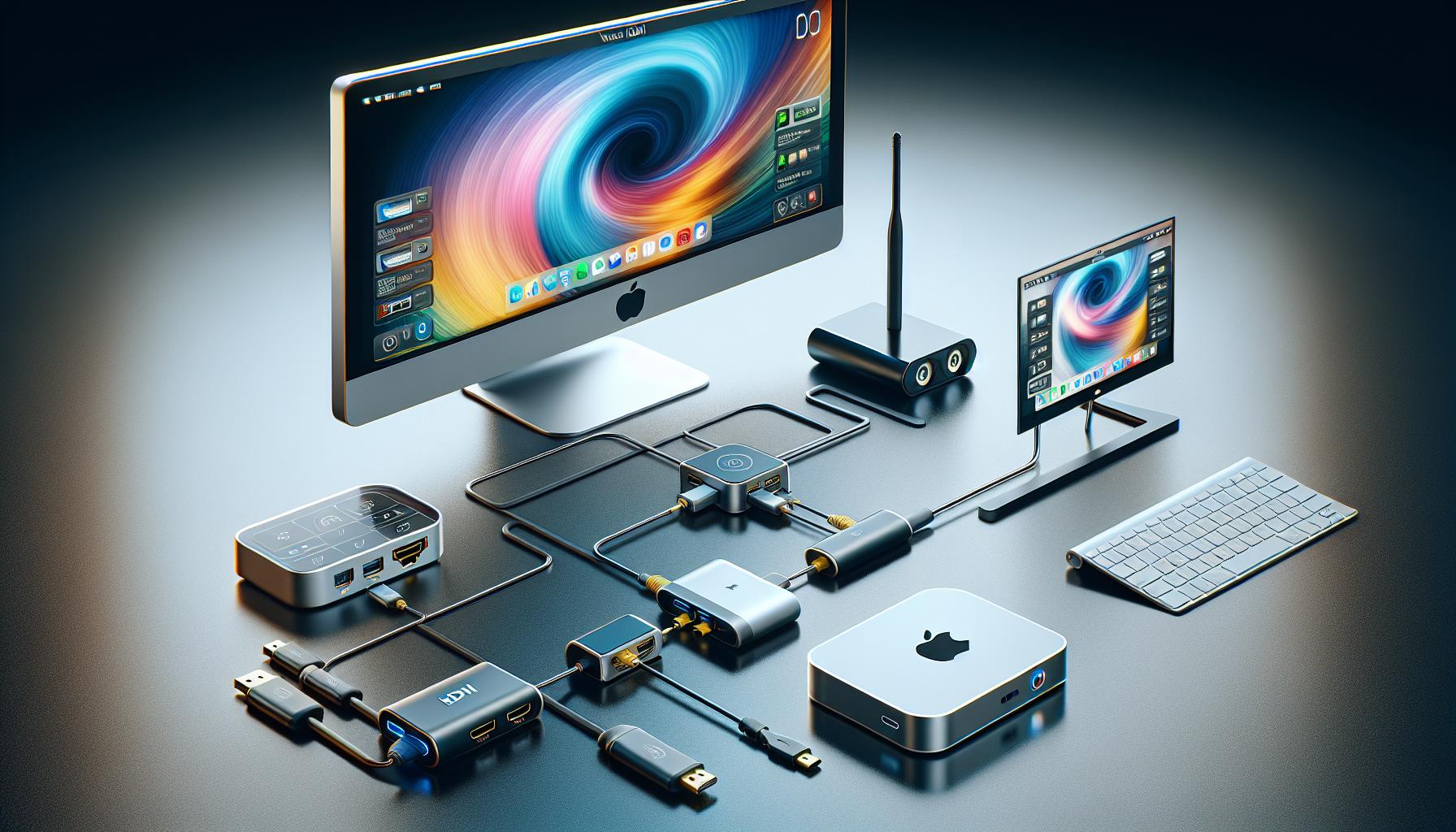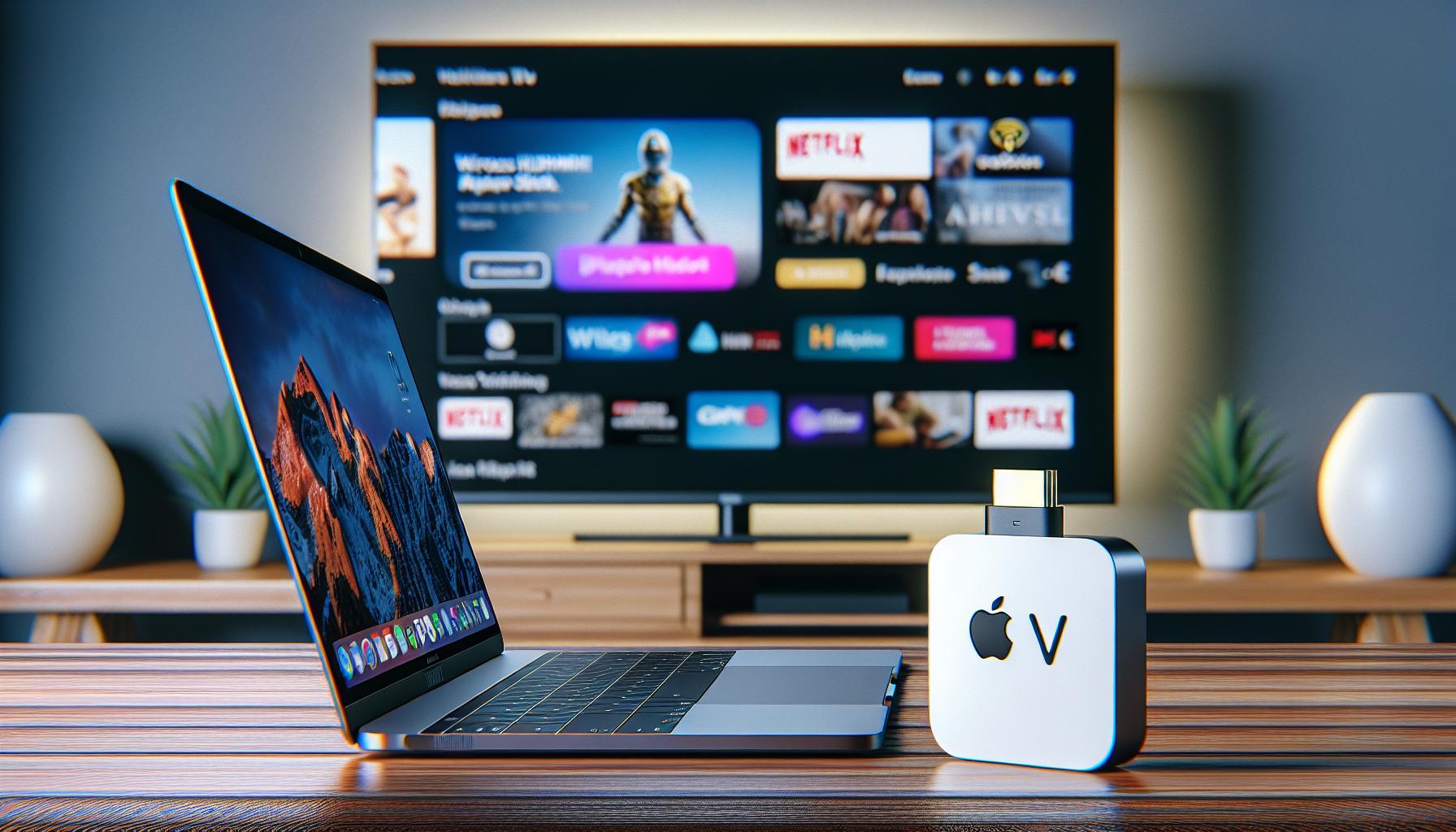Ever wondered how to connect your Mac to your TV wirelessly without an Apple TV? You're not alone. It's a common query among Mac users who want to enjoy their content on the big screen. Luckily, there are several ways to do this, and you don't need to be a tech wizard to figure them out.
In this guide, we'll walk you through the steps to mirror your Mac screen onto your TV, no Apple TV required. Whether you're looking to stream a movie, share a presentation, or just want a bigger workspace, we've got you covered. So, let's dive in and get your Mac and TV talking to each other.
Why connect your Mac to your TV wirelessly
You may wonder, why go through the hassle of connecting your Mac to your TV wirelessly? The reasons are many and compelling enough to explore this option.
Firstly, it allows you to enjoy a larger viewing platform. Your huge TV screen makes for a more immersive and enjoyable experience whether you're streaming movies, making video calls, or simply scrolling through your pictures. Enhance your visual experience by bringing your small Mac screen to the big stage.
Secondly, it amplifies your productivity game. By mirroring your Mac on the TV, your workspace gets a whole new dimension. This is especially useful when you're working from home or handling complex projects that require more screen real estate. You'd be surprised how your productivity scales up when you're not squinting at your small laptop screen all day.
Thirdly, it's an excellent tool for presentations. Gone are the days when you had to huddle around a laptop screen to view a presentation. With your Mac wirelessly connected to your TV, you can easily share your documents, PowerPoints, or commercial proposals. This makes business meetings or family gatherings much more comfortable and professional.
Here's a quick overview of the key benefits:
| Benefits | Examples |
|---|---|
| Larger viewing platform | Movies, video calls, picture browsing |
| Enhanced productivity | Work from home, big projects |
| Excellent for presentations | Business meetings, family gatherings |
Connecting your Mac to your TV wirelessly is not just trendy - it's about taking advantage of technology to improve your experience and productivity. Now, let's proceed to discuss how to make this wireless connection without using an Apple TV.
Option 1: Using a wireless HDMI adapter

Undoubtedly, there's a myriad of ways to connect your Mac to your TV wirelessly. One approach, particularly useful when not using an Apple TV, involves a wireless HDMI adapter. This ingenious device offers impressive compatibilities, proving itself as a reliable option for those with Macs and non-Apple TVs.
Just what is a wireless HDMI adapter, you might wonder? Simply put, it's a device which takes HDMI signals from your Mac, converts them to a wireless signal, and sends them to your TV. This conversion process maintains high-quality images and audio, making it a practical solution for enhancing your viewing experiences, improving productivity, or powerhouse presentations.
To utilize a wireless HDMI adapter, you'll need to plug the transmitter into your Mac. This could be via a USB port or HDMI port depending on your specific model and adapter type. The next step involves connecting the receiver part of the HDMI adapter into your TV. Once that's done, you're all setup and your Mac's content will mirror on your TV.
A few notable wireless HDMI adapters in the market worth checking out include:
- IOGear GW3DHDKIT Wireless HDMI Digital Kit: Known for its ease of installation and high-quality transmission even through walls.
- J-Tech Digital HDbitT Series 1X2 Wireless HDMI Extender: Popular for its long-range wireless coverage.
When making your decision, it’s also vital to focus on factors like range, ease of setup and price to best align the product with your needs. Though it may require an initial investment, it's a worthy addition that aids seamless connections, promising a variety of benefits from better viewing experiences to heightened productivity.
Now that we've covered this, we can explore some other options available for wirelessly connecting your Mac to your TV without the need of an Apple TV.
Option 2: Using AirPlay
AirPlay offers another practical way to connect your Mac to a TV wirelessly - no Apple TV necessary. This protocol allows wireless streaming between devices of audio, video, device screens, and photos. It's a built-in feature in many Apple devices, and you can find it in many third-party devices too.
After you've completed the initial setup, you'll be able to use AirPlay to showcase your work, stream your favorite show, or ramp up the multimedia experience. It's all about getting the most out of what technology has to offer.
Setting up AirPlay isn't complicated. First, check if your devices are AirPlay compatible. This is critical: you can only connect devices if they both support AirPlay. Most Macs and many smart TVs have inbuilt AirPlay support. You can also buy an external device to add AirPlay functionality.
Once you've confirmed AirPlay compatibility, you need to connect both devices to the same Wi-Fi network. Then on your Mac, click the AirPlay icon (which looks like a TV with a triangle at the bottom) in the menu bar. A list of available devices will appear. Choose your TV from this list, and you're all set.
There are a few things to keep in mind while using AirPlay. First, ensure both devices stay connected to the same network. Any interruption can disrupt the streaming. Also, remember that certain applications, such as Netflix, might have restrictions on the use of AirPlay due to copyright issues.
Option 3: Using Chromecast
Yet another viable option to connect your Mac to a TV without an Apple TV is by using Google's Chromecast. This practical and affordable device works well with many digital gadgets, including your Mac.
To start using Chromecast, you'll first need to purchase and plug this handy little gadget into your TV. Next, you'll download the Google Home app onto your Mac, which allows your devices to communicate with each other. It's crucial to remember that both your Mac and the Chromecast must be connected to the same Wi-Fi network for the streaming to work smoothly.
After you've finished setting up the Google Home app, you can cast what's on your Mac directly onto your TV. Whether you are showing a presentation, sharing family photos, or streaming your favorite content, Chromecast's compatibility with a wide range of apps ensures you get the most out of your wireless experience.
Moreover, Chromecast is a favorite for those who heavily use the Chrome browser as it offers a built-in casting feature. With just a few clicks, you can push whatever's on your Chrome browser tab directly onto your big screen. This functionality is particularly useful for quick switches between work documents, educational tutorials, or entertainment platforms.
While Chromecast is user-friendly, it's important to note some potential challenges you may encounter. One common issue is loading delays or buffering when streaming high-definition content. To mitigate this, ensure your Wi-Fi connection is stable and robust.
Take note though, not all applications will support direct casting through Chromecast. There are specific apps like Netflix with restrictions due to copyright issues. However, the list of compatible apps is continually expanding, and many other entertainment platforms support streaming through Chromecast.
Despite these minor limitations, Chromecast offers an efficient means of wirelessly connecting your Mac to your TV. It's a solid choice if you're on a budget or if you appreciate the versatility of using a wide variety of apps. The setup is simple, providing you with an effortless way to enjoy all your Mac’s digital content on a larger screen.
Conclusion
You've now got three solid options for wirelessly linking your Mac to your TV without an Apple TV. Whether you choose a wireless HDMI adapter, AirPlay, or Google's Chromecast, you're set for a seamless streaming experience. Remember, the key is ensuring both devices are on the same Wi-Fi network. While there might be a few hiccups with certain apps and high-definition content, these methods are still efficient and budget-friendly. So, go ahead and enjoy your favorite shows and movies on the big screen, right from your Mac. Happy streaming!
Frequently Asked Questions
What are the options for wirelessly connecting a Mac to a TV without an Apple TV?
The options are using a wireless HDMI adapter, using AirPlay - a protocol that allows wireless streaming between devices, and Google's Chromecast -which allows you to cast from your Mac to your TV.
How does a wireless HDMI adapter work?
The Wireless HDMI adapter connects the Mac to the TV without wires. Full setup instructions are beyond the scope of this summary but typically involve connecting the adapter to your TV and pairing it with your Mac.
What is required to use the AirPlay feature?
To use AirPlay, both the TV and the Mac need to be connected to the same Wi-Fi network. Certain applications, like Netflix, may have restrictions on using AirPlay due to copyright issues.
How does Google's Chromecast work?
Google's Chromecast involves plugging the Chromecast device into the TV, downloading the Google Home app on the Mac, and connecting both devices to the same Wi-Fi network. It allows for casting content from the Mac to the TV and is compatible with various apps.
Are there any limitations to using Google's Chromecast?
There may be loading delays or buffering when streaming high-definition content with Google's Chromecast. Also, not all applications support direct casting through Chromecast. Despite these limitations, it offers an efficient and budget-friendly way to connect a Mac to a TV wirelessly.




